
Summary
This chapter took a very deep dive on a small handful of subjects. We delivered a carefully considered definition of a network, and then considered how the key components of that definition impact our development strategies for network programs. We considered the distinction between a physical and logical network topology, and then explored the most common logical topologies we'll be working with. Lastly, we considered what kinds of new design decisions and strategies we'll have to make as we start to write our first network programs, as well as the .NET classes that will help us implement those strategies easily and cleanly.
In the next chapter, we'll take the first steps into programming for networks, as we look into resource location and addressing.